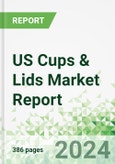This report covers food packaging demand by Market, Material, and Application. Data are provided in current dollar value and units.
Markets for cups and lids include:
- Foodservice
- Food and beverage packaging
- Retail/Home use
- Other markets, including medical and dental, pet food, and nonfood packaging
Applications for cups and lids include:
- Beverage cups and lids
- Food cups and lids
- Portion cups and lids
- Packaging cups and lids
Materials for cups and lids include:
- Rigid plastic
- Foam
- Flexible plastic
- Paper
- Molded fiber
- Metal
Scope of the Report
This report covers the scope, size, and growth of the US market for disposable cups and lids, including key trends in materials and market segments. Historical data are provided for 2012, 2017, and 2022, with forecasts through 2032. Annual data is also provided for 2018 through 2026. Data are provided in current dollar value and units. Also included is an analysis of key industry players.Table of Contents
1. Executive Summary
Companies Mentioned
- Berry Global
- Dart Container
- Graphic Packaging
- International Paper
- Pactiv Evergreen








